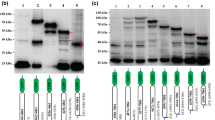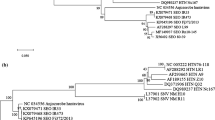Summary
The DNA sequence of 4005 nucleotides from the Kpnl O and part of Kpnl K fragments in the short unique region of infectious laryngotracheitis virus (ILTV) was determined. The sequence contained two complete and one partial open reading frames (ORFs). The partial ORF was open at the 5′ end of the sequence and represented the NH2-terminal 118 amino acids (aa) of a polypeptide. Its partial predicted protein product exhibited significant homology to the US2 gene product of HSV-1 (herpes simplex virus type 1) and its homologs in other herpesviruses. ORF 2 is 471 aa long and could encode a protein of 53.8 kDa which shared aa homology with the protein kinases encoded by HSV-1 US3 and its gene homologs. Analysis of the ORF 2 aa sequence revealed domains characteristic of protein-serine/threonine (S/T) kinases of cellular and viral origin. The ORF 3 encoded a predicted protein of 601 aa (Mr 67.5 kDa) which exhibited limited homology (18% overall identity) with the UL47 protein (major tegument protein) of HSV-1. Northern (RNA) blot hybridization and metabolic inhibitors were used to characterize the ILTV protein kinase and the 67K mRNAs. The data revealed that protein kinase is a gamma-1 gene encoding a 1.6 kb mRNa, while the 67K ORF is a gamma-2 gene encoding a 2 kb mRNA.
Similar content being viewed by others
References
Barker DE, Roizman B (1990) Identification of the three genes non-essential for growth in cell culture near the right terminus of the unique sequences of long component of herpes simplex virus 1. Virology 177: 684–691
Cantello JL, Anderson AS, Francesconi A, Morgan RW (1991) Isolation of a Marek's disease virus (MDV) recombinant containing the lacZ gene of Escherichia coli stably inserted within the MDV US2 gene. J Gen Virol 65: 1584–1588
Davison AJ, Scott JE (1986) The complete DNA sequence of varicellazoster virus. J Gen Virol 67: 1759–1816
Frame MC, Purves FC, McGeoch DJ, Marsden HS, Leader DP (1987) Identification of the herpes simplex virus protein kinase as the product of viral gene US3. J Gen Virol 68: 2699–2704
Griffin AM, Boursnell MEG (1990) Analysis of the nucleotide sequence of DNA from the region of the thymidine kinase gene of infectious laryngotracheitis virus; potential evolutionary relationships between the herpesvirus subfamilies. J Gen Virol 71: 841–850
Hanks SK, Quinn AM, Hunter T (1988) The protein kinase family: conserved features and deduced phylogeny of the catalytic domains. Science 241: 42–52
Hanks SK, Quinn AM (1991) Protein kinases and phosphorylation site sequences. Methods Enzymol 200: 38–62
Higgins DG, Bleasby AJ, Fuchs R (1992) CLUSTALV: improved software for multiple sequence alignment. Comput Appl Biosci 8: 189–191
Honess RW, Roizman B (1974) Regulation of herpesvirus macromolecular synthesis. I. Casade regulation of the synthesis of three groups of viral proteins. J Virol 14: 8–19
Johnson MA, Prideaux CP, Kongsuwan K, Sheppard M, and Fahey KJ (1991) Gallid herpesvirus 1 (infectious laryngotracheitis virus): cloning and physical maps of the SA-2 strain. Arch Virol 119: 181–198
Johnson MA, Tyack SG, Prideaux CT, Kongsuwan K, Sheppard M (1994) Complete nucleotide sequence of infectious laryngotracheitis virus (gallid herpesvirus 1) ICP4 gene. Virus Res (submitted)
Johnson MA, Tyack SG, Prideaux CT, Kongsuwan K, Sheppard M (1994) Sequence characteristics of a gene in infectious laryngotracheitis virus, homologous to glycoprotein D of herpes simplex virus. DNA Seq J DNA Seq Map (in press)
Knighton DR, Zheng J, Ten Eyck LF, Ashford VA, Xuong N-G, Taylor SS, Sowadski JM (1991a) Crystal structure of the catalytic subunit of cyclic adenosine monophosphate-dependent protein kinase. Science 253: 407–409
Knighton DR, Zheng J, Ten Eyck LF, Xuong N-G, Taylor SS, Sowadski JM (1991b) Structure of a peptide inhibitor bound to be the catalytic subunit of cyclic adenosine monophosphate-dependent protein kinase. Science 253: 414–420
Kongsuwan K, Prideaux CP, Johnson MA, Sheppard M, Fahey KJ (1991) Nucleotide sequence of the gene encoding infectious laryngotracheitis virus glycoprotein B. Virology 184: 404–410
Kongsuwan K, Johnson MA, Prideaux CP, Sheppard M (1993) Identification of an infectious laryngotracheitis virus gene encoding an immunogenic protein with a predicted M r of 32 kilodaltons. Virus Res 29: 125–140
Kongsuwan K, Johnson MA, Prideaux CT, Sheppard M (1993) Use of γgt11 and monoclonal antibodies to map the gene for the 60,000 dalton glycoprotein of infectious laryngotracheitis virus. Virus Genes 7: 297–303
Kongsuwan K, Prideaux CT, Johnson MA, Sheppard M (1994) Identification and characterization of the infectious laryngotracheitis virus glycoprotein 60. J Gen Virol (submitted)
Kozak M (1986) Point mutation defines a sequence flanking the AUG initiator codon that modulates translation by eukaryotic ribosomes. Cell 44: 283–292
Leib DA, Bradbury JM, Hart CA, McCarth K (1987) Genome isomerism in two alphaherpesviruses: Herpesvirus saimiri-1 (Herpesvirus tamarinus) and avian infectious laryngotracheitis virus. Arch Virol 93: 287–294
Longnecker R, Roizman B (1987) Clustering of genes dispensable for growth in culture in the S component of the HSV-1 genome. Science 236: 573–576
McGeoch DJ, Dolan A, Donald S, Rixon FJ (1985) Sequence determination and genetic content of the short unique region in the genome of herpes simplex virus type 1. J Mol Biol 181: 1–13
McGeoch DJ, Dalrymple MA, Davison AJ, Dolan A, Frame MC, NcNab D, Perry LJ, Scott JE, Taylor P (1988) The complete DNA sequence of the long unique region in the genome of herpes simplex virus type 1. J Gen Virol 69: 1531–1574
McKnight JLC, Pellett PE, Jenkins FJ, Roizman B (1987) Characterization and nucleotide sequence of two herpes simplex virus 1 genes whose products modulate α-trans-inducing factor-dependent activation of α genes. J Virol 61: 992–1001
McLean G, Rixon F, Langeland N, Haarr L, Marsden H (1990) Identification and characterization of the virion products of herpes simplex virus type 1 gene UL47. J Gen Virol 71: 2953–2960
Nagesha HS, Crabb BS, Studdert MJ (1993) Analysis of the nucleotide sequence of five genes at the left end of the unique short region of the equine herpesvirus 4 genome. Arch Virol 128: 143–154
Petrovskis EA, Timmins JG, Gierman TM, Post LE (1986) Deletions in vaccine strains of pseudorabies virus and their effect on synthesis of glycoprotein gp63. J Virol 60: 1166–1169
Plummer G, Goodheart CR, Henson D, Bowling CP (1969) A comparative study of the DNA density and behaviour in tissue cultures of fourteen different herpesviruses. Virology 39: 134–137
Prideaux CP, Kongsuwan K, Johnson MA, Sheppard M, Fahey KJ (1992) Infectious laryngotracheitis virus growth, DNA replication, and protein synthesis. Arch Virol 123: 181–192
Purves FC, Deana AD, Marchiori F, Leader DP, Pinna LA (1986) The substrate specificity of the protein kinase induced in cells infected with herpesviruses: studies with synthetic substrates indicated structural requirements distinct from other protein kinases. Biochem Biophys Acta 889: 208–215
Purves FC, Spector D, Roizman B (1991) The herpes simplex virus 1 protein kinase encoded by the US3 gene mediates posttranslational modification and the phosphoprotein encoded by the UL34 gene. J Virol 65: 5757–5764
Ross LJN, Binns MM, Pastorek J (1991) DNA sequence and organization of genes in a 5.5 kbp EcoRI fragent mapping in the short unique segment of Marek's disease virus (strain RBIB). J Gen Virol 72: 949–954
Telford EAR, Watson MS, McBride K, Davison AJ (1992) The DNA sequence of equine herpesvirus-1. Virology 189: 304–316
Whittaker GR, Riggio MP, Halliburton IW, Killington RA, Allen GP, Meredith DM (1991) Antigenic and protein sequence homology between VP13/14, a herpes simplex virus type 1 tegument protein, and gp10, a glycoprotein of equine herpesvirus 1 and 4. J Virol 65: 2320–2326
Zhang G, Stevens R, Leader DP (1990) The protein kinase encoded in the short unique region of pseudorabies virus: description of the gene and identification of its product in virions and in infected cells. J Gen Virol 71: 1757–1765
van Zijl M, van der Gulden H, de Wind N, Gielkens A, Berns A (1990) Identification of two genes in the unique short region of pseudorabies virus; comparison with herpes simplex virus and varicella-zoster virus. J Gen Virol 71: 1747–1755
Author information
Authors and Affiliations
Rights and permissions
About this article
Cite this article
Kongsuwan, K., Prideaux, C.T., Johnson, M.A. et al. Nucleotide sequence analysis of an infectious laryngotracheitis virus gene corresponding to the US3 of HSV-1 and a unique gene encoding a 67 kDa protein. Archives of Virology 140, 27–39 (1995). https://doi.org/10.1007/BF01309721
Received:
Accepted:
Issue Date:
DOI: https://doi.org/10.1007/BF01309721




